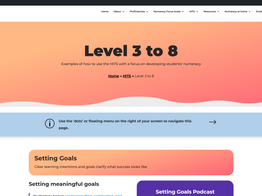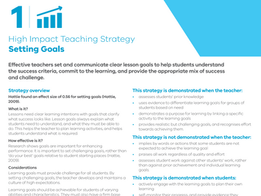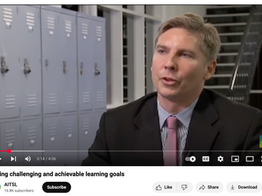Overview

Lessons need clear learning intentions with goals that clarify what success looks like. Lesson goals always explain what students need to understand, and what they must be able to do.
This helps the teacher to plan learning activities, and helps students understand what is required.
Key Elements
-
Based on assessed student needs
-
Goals are presented clearly so students know what they are intended to learn
-
Can focus on surface and/or deep learning
-
Challenges students relative to their current mastery of the topic
-
Links to explicit assessment criteria

Related Effect Sizes
-
Goals – 0.56
-
Teacher clarity – 0.75
This strategy is demonstrated when the teacher:
Assesses students’ prior knowledge.
Uses evidence to differentiate learning goals for groups of students based on need.
Demonstrates a purpose for learning by linking a specific activity to the learning goals.
Provides realistic but challenging goals, and recognises effort towards achieving them.
This strategy is NOT demonstrated when the teacher:
Implies by words or actions that some students are not expected to achieve the learning goal
Praises all work regardless of quality and effort
Assesses student work against other students’ work, rather than against prior achievement and individual learninggoals.
This strategy is demonstrated when students:
Actively engage with the learning goals to plan their own learning.
Self-monitor their progress, and provide evidence they believe demonstrates they have achieved their goals
Frame future learning goals based on identified strengths and areas for improvement.
Typical problems of practice in this area:
Students might struggle to articulate clear, specific, and achievable goals.
Anxiety about not meeting expectations can prevent students from setting ambitious goals or taking necessary risks.
Goals are generic and do not consider the individual growth of the learner.
Setting goals that are too ambitious or beyond a student’s current capabilities can lead to frustration and discouragement.
Without regular check-ins and constructive feedback, students may lose focus or become unaware of their progress.
Goals imposed by teachers or parents, rather than self-driven goals, can reduce intrinsic motivation.
Possible LfL questions to ask students
JS: "What are you learning today?”
“What do you need to do to achieve this learning today?”
“Is this lesson easy, just right or hard? Why?”
What do you think makes a good goal?
How do you know if a goal is too easy or too hard?
Have you ever set a goal and not achieved it? What happened?
How can setting goals help you stay organized and manage your time better?
How do you feel when you achieve a goal you worked hard for?
How can you track your progress towards a goal?
Reminder of the TLPP
-
Learners experience supportive, respectful, and authentic relationships
-
Learners thrive in an environment that is both safe and challenging
-
Learners understand the purpose of their learning
-
Learners readily connect new learning with previous knowledge, concepts and skills
-
Learners feel individually challenged at an appropriate level
-
Learners have increasing agency in their learning
-
Learners receive ongoing feedback
-
Learners experience a range of learning and teaching methodologies
-
Learners have ample opportunities to practise
-
Learners have regular opportunities to collaborate with and learn from others

Training Materials from GTT (Great Teaching Toolkit)
How the Great Teaching Toolkit supports this HIT
Element 3.1 Managing time and resources (This element has a focus on classroom routines and strategies for managing poor behaviour)
Element 4.4 Activating (See article “7 goal setting strategies for high expectations teaching”)



















